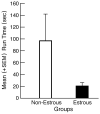The effects of sexual experience and estrus on male-seeking motivated behavior in the female rat
- PMID: 18761024
- PMCID: PMC2574631
- DOI: 10.1016/j.physbeh.2008.08.002
The effects of sexual experience and estrus on male-seeking motivated behavior in the female rat
Abstract
Ovariectomized (OVX) female rats were trained to traverse a straight alley and return to a goal box where they had previously encountered a male rat, a female rat or an empty goal box. The time required to run the alley was used as an index of the subjects' motivation to re-engage the goal box target. Subjects were tested in both estrus and non-estrus, first sexually naïve and then again after sexual experience. Female rats ran most quickly for a male target, most slowly for an empty goal box, and at intermediate speeds for a female target. Sexual experience tended to slow run times for all but male targets. Estrus enhanced approach behavior for males and an empty goal box, but tended to slow the approach toward females, both before and after sexual experience. This latter finding was further investigated in a second experiment in which sexually naïve OVX females were tested during estrus and non-estrus in a locomotor activity apparatus, a runway with an empty goal box, and an open field. Estrus produced no changes in spontaneous locomotion either in the activity box or the open field, but decreased run times in the alley and increased the number of center-square entries in the open-field. Thus, estrus produces increases in sexual motivation that selectively enhance exploratory, presumably male-seeking behavior, but not simple spontaneous locomotion.
Figures





References
-
- Beach FA. Sexual attractivity, proceptivity, and receptivity in female mammals. Horm Behav. 1976;7(1):105–138. - PubMed
-
- Acosta-Martínez M, Gonzalez-Flores O, Etgen AM. The role of progestin receptors and the mitogen-activated protein kinase pathway in [delta] opioid receptor facilitation of female reproductive behaviors. Horm Behav. 2006;49(4):458–462. - PubMed
-
- Zanoli P, Zavatti M, Rivasi M, Baraldi M. Ferula hermonis impairs sexual behavior in hormone-primed female rats. Physiol Behav. 2005;86(1–2):69–74. - PubMed
-
- Mazzucco CA, Walker HA, Pawluski JL, Lieblich SE, Galea LAM. ER[alpha], but not ER[beta], mediates the expression of sexual behavior in the female rat. Behav Brain Res. 2008 In Press, Corrected Proof. - PubMed
Publication types
MeSH terms
Grants and funding
LinkOut - more resources
Full Text Sources
Miscellaneous

